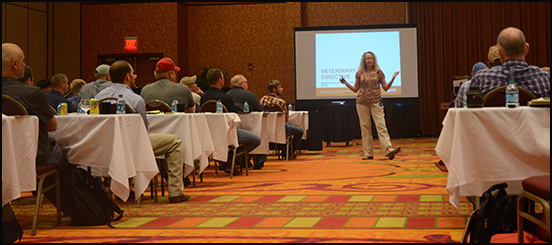
Get Set for New VFD Regulations
Producers must establish relationships with veterinarians.

Consumer interest in how food animals are raised and antibiotic use along the way has spurred regulatory change at the federal level, according to Zoetis veterinarian Marilyn Corbin.
There’s no simple, precise formula for how to raise the best cattle and ultimately the best beef. Producers keep looking for better ways and technology to gain quality and efficiency, but those are continually tweaked by internal and external forces.
Consumer interest in how food animals are raised and antibiotic use along the way has spurred regulatory change at the federal level, according to Zoetis veterinarian Marilyn Corbin. She provided an overview of pending changes in the Veterinary Feed Directive (VFD) regulations at the recent Feeding Quality Forums in Omaha, Neb., and Garden City, Kan.
Among 180 attendees, everyone had heard of the VFD, but nearly all admitted they did not know how the new rules would affect them when they go into effect in January 2017.
“An easy way to think about it is simply a prescription that you have to use if you’re feeding a feed-grade antibiotic,” Corbin said.
The U.S. Food and Drug Administration (FDA) had VFD rules in place since 2001. These were updated to address concerns and combat efforts by special-interest groups seeking to remove all uses of feed-additive antibiotics in livestock production under the unfounded argument that such use creates antibiotic resistance in humans.
By working with the FDA to revise the VFD, producers and veterinarians showed their commitment to using the most informed and effective methods to keep animals healthy while preserving the efficacy of antibiotics in human medicine, Corbin said.
Three explanations
She noted three FDA documents that help explain the VFD.
Guidance 152 lists antibiotics included in the VFD rules, which are all those important in both livestock production and human medicine. Ionophores and coccidiostats are not included.
Next, Guidance 209 defines the goal of the directive — to ensure “judicious use” of antibiotics — stipulating feed-additive and water-soluble antibiotics be used for disease treatment, control and prevention but not for growth promotion. Veterinarians will oversee this process and be responsible for deciding how and when these antibiotics will be used.
Finally, Guidance 213 is the road map for implementing judicious use.
In the near future, antibiotics will be classified as either Category I or Category II.
“A Category I, for example, would be a drug that had no risk to human health whatsoever and was not VFD,” Corbin said. “A Category II would be a drug that maybe had some risks to human health and/or it was a VFD drug.” Risk status will primarily note whether the drug has a withdrawal period.
Producers should pay attention to these classifications because any drug classified as “Category II” will require a feedmill license and ultimately a few more pieces of paperwork for validation.
Extra paperwork is likely to be a common theme. Distributors — someone who distributes a VFD product to another distributor or a client — will be responsible for their own portion of paperwork, as well as sending a letter of intent to the FDA.
“Basically you have to raise your hand and say, ‘Hey, I’m going to use a VFD product,’ ” Corbin said, but for most people it will be a one-time requirement.
There will be three copies of each granted VFD permit, one each for the veterinarian, the distributor and the client. All three parties will be responsible for keeping that file on record for two years, either in electronic or physical form.
Each permit will be valid for six months unless it specifically lists a different expiration. Filling out the form will require an estimate of how many cattle may require certain VFD products during that six-month period. Feeding a VFD product without a valid form on hand will be illegal.
Labeling of brand-name and generic products could be an area of confusion, Corbin warned. Veterinarians must specify on the form if they do not want a brand-label product to be substituted with a generic form; otherwise, the two can be used interchangeably. However, that only applies if the generic and brand-name products have the exact same label combinations.
Aside from the details of paperwork, drug labeling, classification and the like, she said the most important thing for producers to do right now is start communicating.
“When veterinarians write out VFDs, they are accepting certain legal liabilities and saying they have sufficient knowledge of a client’s operation,” Corbin said. “This is called a valid veterinarian-client-patient relationship (VCPR). Veterinarians may refuse to give out a VFD if they do not have the proper working relationship and knowledge for that operation.” Producers with animals in multiple states will need to make sure their veterinarian is licensed in those states, as well.
“Then find your nutritionist,” Corbin said. “Even though he’s not writing the VFD, he’s going to be intimately involved because it affects his rations. But here’s the really tough one — make sure your veterinarian and your nutritionist talk to each other.”
Setting up these meetings and discussing all the necessary details may take time, so Corbin advised starting the process now.
There are still many clarifications that need to be made before this directive is put into place. For example, VFD forms are still being configured, and the FDA says the method of inspections and determining compliance “has not been determined yet.”
At this point the most important step producers need to take is to start the conversations with veterinarians and nutritionists so they can be as prepared as possible when the new VFD rules go into effect.
The Feeding Quality Forum was sponsored by Certified Angus Beef LLC, Zoetis, Feedlot magazine, Roto-Mix, IntelliBond and Purina.
For more about VFDs, see “Vet Call” in the September 2015 Angus Journal and “How Will VFD Affect You?” which will be in the October Angus Journal.

Editor’s Note: Lyndee Stabel is a freelance writer for Certified Angus Beef LLC.





